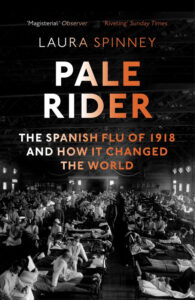 Laura Spinney
Laura Spinney
Pale Rider: The Spanish Flu of 1918 and How It Changed the World
The flu virus spanned the globe and killed countless millions, especially during the second wave in September to December 1918. It may have hastened the end of the First World War; it certainly hastened many to an early grave and disrupted politics, medicine, religion and arts.
Laura Spinney, a science writer, has delved into the history of the pandemic, investigating where it started, how it spread and how governments around the world responded. It turns out that the pandemic did not start in Spain and it remains unclear whether it originated in the battlefields of Europe or possibly in America where troops gathered to travel to France. It infected something like one in three people on earth and killed between 50-100 million or 2.5-5% of the global population. Spain was a neutral country with an uncensored press which freely reported the impact of the flu – hence it was attributed to Spain. In 2015 the World Health Organisation issued guidelines about naming diseases. Names should not make reference to places, people, animals or food.
Medical science did not know about viruses, but they had worked out that germs caused disease. There was no testing or accurate counting of the dead. Many of the actions of promoting cleanliness, quarantine, wearing masks are now familiar to us. The first wave started in March 1918. In August it returned transformed and more lethal. No doubt the World War contributed as ships, supplies and people crossed the seas and spread the virus. A complication of pneumonia caused most of the deaths.
Spinney tells lots of stories about people, places and the times from around the globe. She cleverly illustrates the ‘doctors dilemma’ where underlying poverty and disease in many countries made diagnosis of flu harder than we might expect. She tells the story of the Spanish city of Zamora, where a new young Bishop had just arrived along with returning soldiers. The Bishop defied the health authorities ordering various religious ceremonies with crowds of people; the city suffered worse than any other in Spain.
A key lesson drawn out from the various responses is the need to place the interests of the collective over those of the individual. Top down imposition of disease containment strategies creates economic and civil liberty problems. Painful readjustments are needed on the road to recovery. Improvements in healthcare resulted from the 1918 Flu although it took until after the Second World War for those to be implemented in Britain.
There is much to learn from this book about a period in our history usually dominated by First World War and the consequences. Yet the pandemic may well have had a greater global impact. Whilst very well researched in terms of facts and stories about the pandemic around the world, it is weaker in the final section on the post-flu world. Working out our own post-Covid world is the challenge that we face. Perhaps we might give more emphasis on disease prevention and valuing those who serve others in times of crisis.
Review by Canon Mike D Williams